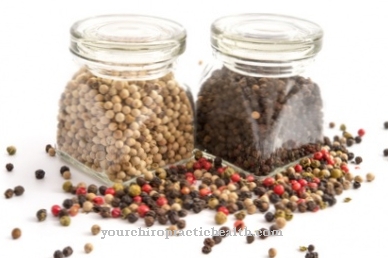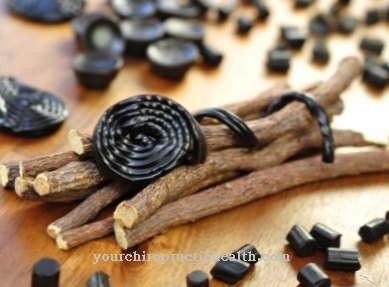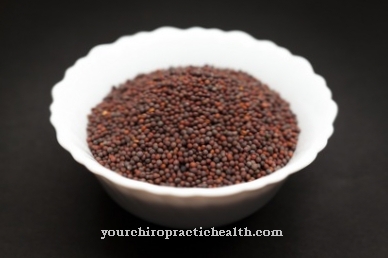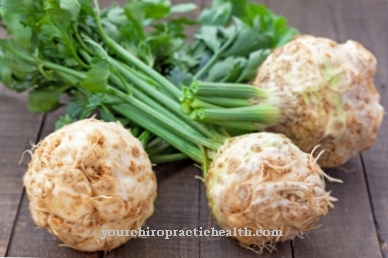Grapefruit is a cross between orange and grapefruit, which has been cultivated commercially since around 1875, initially in Florida, and later almost worldwide in subtropical countries.
In addition to potassium, calcium and magnesium, the fruits provide health-relevant amounts of antioxidants, especially vitamin C. It must be borne in mind that certain secondary plant substances in grapefruit interact strongly with many drugs, including statins, beta blockers and some blood pressure lowerers.
What you should know about grapefruit

Grapefruit is a citrus fruit with a sweet-sour and slightly bitter taste, which is caused by the secondary plant substance naringin. The fruit with a diameter of 10 to 15 centimeters and a 1 centimeter thick skin is a cross between grapefruit and orange and is often incorrectly referred to as grapefruit.
The grapefruit is probably a chance product that originated on the Caribbean island of Barbados around 1750. From around 1870 onwards, the tasty citrus fruit with its slightly tart and bitter undertone was first grown commercially in Florida. Florida and Texas are still the main growing areas today, although the fruit is now grown in plantations in almost all subtropical countries around the world. The main suppliers for Europe are Israel, Cyprus, Spain and also South Africa. Both main types, the white grapefruit with yellowish and the red grapefruit with reddish to rosé-colored flesh can be found on the market, whereby the red grapefruit was further cultivated into several different varieties.
The red varieties, whose skin is already recognizable by their slightly reddish hues, usually taste sweeter and milder than the yellow-fleshed grapefruit. It is a good fit for the temperate zones in the northern hemisphere such as Central and Northern Europe that the main season of grapefruit as a vitamin supplier covers the winter half of the year from October to April. In the winter months, the supply of vitamins and other important secondary plant substances such as enzymes, polysaccharides and trace elements from local plant products is limited in Central and Northern Europe, and the low sun in connection with frequent low-pressure areas specifically suggests a lack of vitamin D, which can get through the action of sunlight in the skin forms provided that precursors for the formation of vitamin D are present.
Even if the supply of important - metabolically relevant - substances in the summer half of the year is far better with a natural diet than in winter, nobody needs to do without their usual grapefruit. While in the subtropical countries of the northern hemisphere the grapefruit trees bloom in summer and the fruits gradually ripen, in the subtropical countries of the southern hemisphere it is harvest time, so that imports from South Africa and also from other countries south of the equator meet the demand in central and northern Europe during the summer half year can cover.
Importance to health
When food is given health importance, it is usually less about the main nutrient groups carbohydrates, proteins and fats or oils, but more about so-called secondary plant substances such as vitamins, enzymes, polysaccharides, minerals, trace elements and many other organic and inorganic substances.
They only play a subordinate role in terms of their nutritional value, but some of them take on important tasks and functions in the intermediate metabolism and within the immune system. The positive importance of grapefruit for human health lies mainly in its capacity as a supplier of vitamin C, some B vitamins and health-relevant flavonoids and as a supplier of metabolically relevant minerals. Especially in winter, the main harvest time for grapefruit in subtropical areas of the northern hemisphere, the supply of the organism with vitamin C as an effective antioxidant and some B vitamins as well as the supply with minerals and trace elements is of great importance.
As little as 200 to 300 grams of grapefruit cover the daily requirement for vitamin C. However, the pulp and juice also contain special glycosides such as naringin. The glycoside not only ensures improved digestion and a faster feeling of satiety, but also inhibits the breakdown of statins (cholesterol-lowering drugs) and beta blockers (cardiac rhythm stabilization), so that the half-life of the drugs is significantly increased. The effect of the medication increases in an uncontrollable and sometimes dangerous way. The same effect can occur when consuming drugs, so that the effect of the drug can be intensified and prolonged uncontrollably.
Before consuming a grapefruit or its juice, people who regularly have to take tablets should clarify whether ingredients such as naringin interact with the drugs they have taken.
Ingredients & nutritional values
| Nutritional information | Amount per 100 gram |
| Calories 42 | Fat content 0.1 g |
| cholesterol 0 mg | sodium 0 mg |
| potassium 135 mg | carbohydrates 11 g |
| protein 0.8 g | vitamin C 31.2 mg |
With a nutritional value of 35 to 50 kilocalories per 100 grams of pulp, grapefruit is not a calorie bomb, but rather a vitamin C bomb. One hundred grams of pulp contains around 44 milligrams of vitamin C, which is about half of the recommended daily requirement of 100 milligrams and almost equal to the values of lemon.
Potassium is also available in a concentration of around 180 milligrams per 100 grams of pulp, which corresponds to 10 percent of the daily requirement of an adult. The analogous calcium and magnesium content, on the other hand, only reaches values that correspond to 2 to 3 percent of the daily requirement (100 g pulp).
Intolerances & allergies
Like almost all citrus fruits, grapefruits contain biogenic amines, which also include the important messenger substance histamine. Among other things, it plays a special role in inflammatory reactions and is also formed by the body itself from the amino acid histidine.
The juice and pulp of grapefruit are not only suppliers of histamines, but certain ingredients also act as histamine liberators. They cause that additionally produced and z. B. Histamine stored in white blood cells is released. Allergic reactions can therefore occur in people with known histamine intolerance after consumption.
Shopping & kitchen tips
More than 20 different types of grapefruit are available in stores, also in organic quality if required. The individual varieties differ in taste and ingredients. The lighter the skin and flesh, the more bitter and less sweet their taste.
The particularly sweet tasting grapefruit varieties with only a slightly bitter-tart undertone can usually be recognized by the color of their flesh, which ranges from rosé to dark red. Although grapefruits are counted among the fruits that do not ripen later, their taste changes when properly stored outside the refrigerator at 9 to 15 degrees Celsius. The sweetness and aroma increase in intensity, and the tart, bitter undertone in the taste becomes a little weaker. Grapefruits can easily be stored for several weeks under the above conditions.
Preparation tips
A popular way to prepare the fruit for consumption is to cut it in half and separate the pulp from the skin with a special knife with a curved saw edge, and then cut the fruit body into small segments by making straight cuts.
The pulp can then be "spooned out" directly from the skin with a small spoon and eaten. If necessary, you can add a little more sugar. Another method of preparation consists in dividing the pulp into small cubes to garnish salads and other starters and to spice up the taste and appearance a little. Of course, grapefruits can also be juiced, but important ingredients and fiber that are in the pulp are then lost.
























.jpg)



